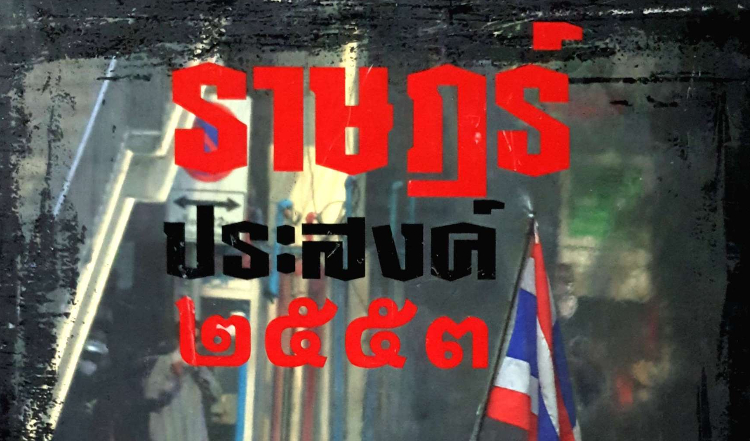
ราษฏร์ประสงค์ ๒๕๕๓ (‘Ratchaprasong 2010’), published in 2011, is a coffee-table book documenting the United Front for Democracy Against Dictatorship (red-shirt) protest movement, and its violent suppression by the military in May 2010. (Names of the dead and injured are listed in an appendix.) Many of the UDD protesters were also supporters of former prime minister Thaksin Shinawatra, and Thaksin wrote a foreword to the book.
Clearly, with its contribution by Thaksin, this is a one-sided history of the red-shirt demonstrations. But it’s a necessary one, as history is usually written by the victors. The book contradicts the accusations of violence and arson levelled at the red-shirts by Thailand’s right-wing media. For example, พฤษภาอำมหิต (‘savage May’), published by Kom Chad Luek (คมชัดลึก), focused almost entirely on the arson committed after the military massacre. Similarly, Suthep Thaugsuban’s book ประเทศไทยของเรา อย่าให้ใครเผาอีก (‘our Thailand: don’t let anyone burn it down again’) presents the UDD as arsonists and terrorists.
Clearly, with its contribution by Thaksin, this is a one-sided history of the red-shirt demonstrations. But it’s a necessary one, as history is usually written by the victors. The book contradicts the accusations of violence and arson levelled at the red-shirts by Thailand’s right-wing media. For example, พฤษภาอำมหิต (‘savage May’), published by Kom Chad Luek (คมชัดลึก), focused almost entirely on the arson committed after the military massacre. Similarly, Suthep Thaugsuban’s book ประเทศไทยของเรา อย่าให้ใครเผาอีก (‘our Thailand: don’t let anyone burn it down again’) presents the UDD as arsonists and terrorists.

In his foreword, Thaksin writes that he is saddened by the violence captured in photographs of the military crackdown, and indeed the publisher’s introduction warns the reader that “THERE ARE PHOTOS OF THOSE WHO WERE INJURED AND DIED.” Again, this challenges the narrative that the protesters were perpetrators, rather than victims, of violence. All photographs of red-shirt casualties were removed from the Rupture (หมายเหตุ ๕/๒๕๕๓) exhibition at Bangkok Art and Culture Centre, leaving only images of damaged buildings.
With its bilingual text, and an expensive ฿1,000 price tag, ราษฏร์ประสงค์ ๒๕๕๓ was presumably aimed at a wider audience, and not merely intended as a souvenir for UDD members. On the other hand, ความจริงวันนั้น (‘the truth about that day’) and, especially, ภาพประวัติศาสตร์ การต่อสู้ของคนเสื้อแดง ที่คนไทยต้องไม่ลืม (‘historic pictures of the red-shirt fight that Thai people must not forget’) are so pro-Thaksin that they would surely appeal only to the protesters themselves.
Two books published by liberal journals, 19-19 ภาพ ชีวิต และการต่อสู้ของคนเสื้อแดง จาก 19 กันยา 2549 ถึง 19 พฤษภา 2553 (‘pictures of the life and struggle of the red-shirts from 19th September 2006 to 19th May 2010’) and กรุงเทพฯ (ไม่) มีคนเสิ้อแดง (‘Bangkok (no) red shirts’), cover the protests with more objectivity. Bangkok, May 2010 provides analysis of the period from both sides of the political divide.
With its bilingual text, and an expensive ฿1,000 price tag, ราษฏร์ประสงค์ ๒๕๕๓ was presumably aimed at a wider audience, and not merely intended as a souvenir for UDD members. On the other hand, ความจริงวันนั้น (‘the truth about that day’) and, especially, ภาพประวัติศาสตร์ การต่อสู้ของคนเสื้อแดง ที่คนไทยต้องไม่ลืม (‘historic pictures of the red-shirt fight that Thai people must not forget’) are so pro-Thaksin that they would surely appeal only to the protesters themselves.
Two books published by liberal journals, 19-19 ภาพ ชีวิต และการต่อสู้ของคนเสื้อแดง จาก 19 กันยา 2549 ถึง 19 พฤษภา 2553 (‘pictures of the life and struggle of the red-shirts from 19th September 2006 to 19th May 2010’) and กรุงเทพฯ (ไม่) มีคนเสิ้อแดง (‘Bangkok (no) red shirts’), cover the protests with more objectivity. Bangkok, May 2010 provides analysis of the period from both sides of the political divide.
